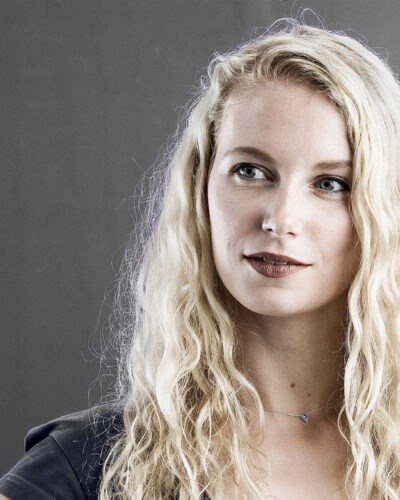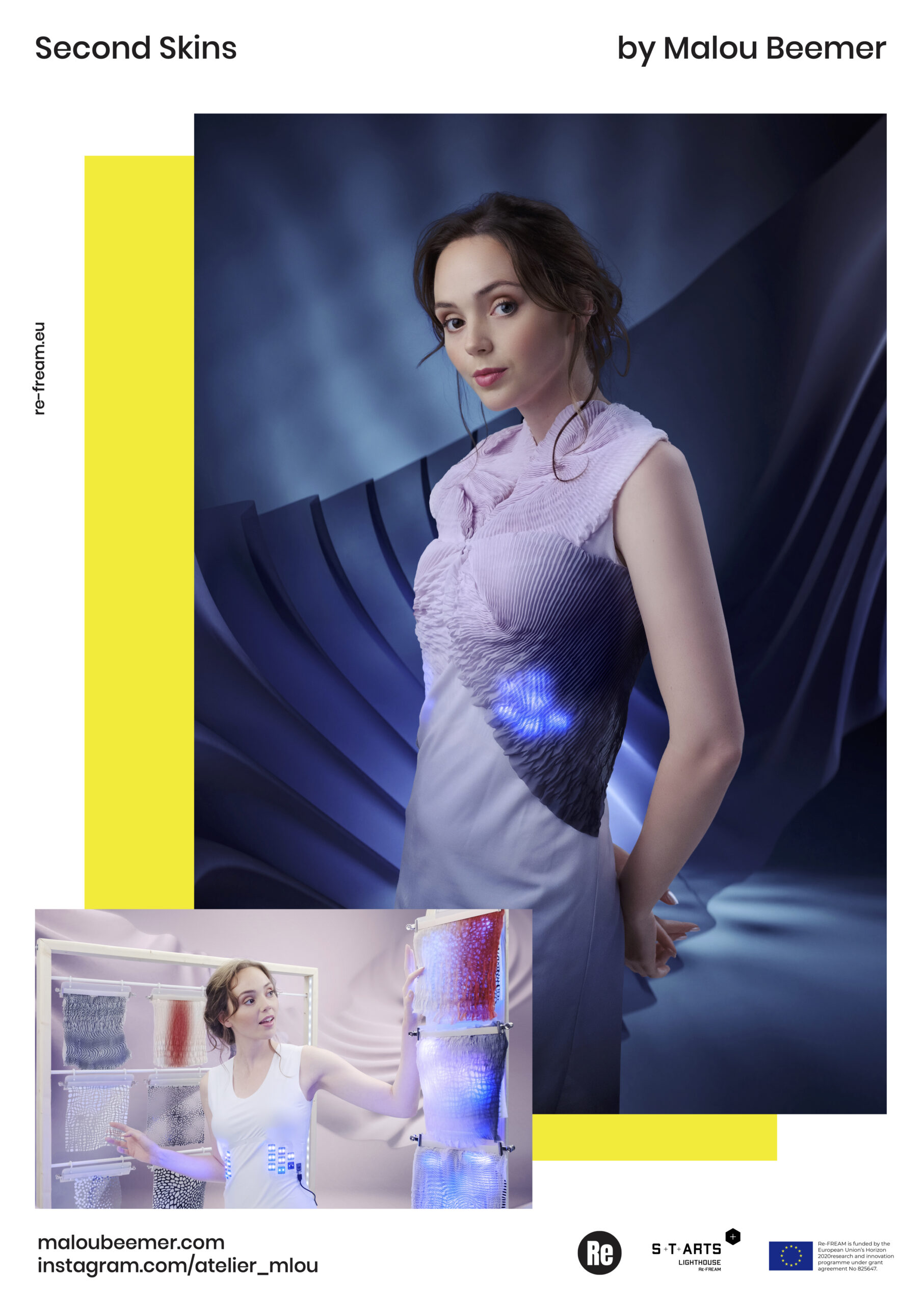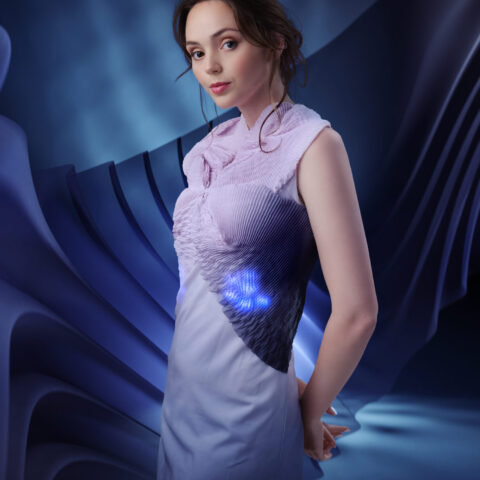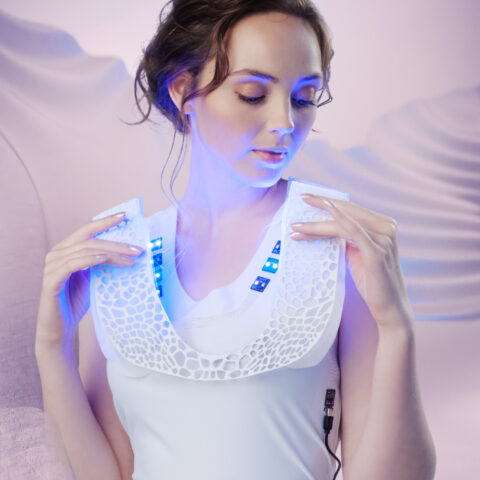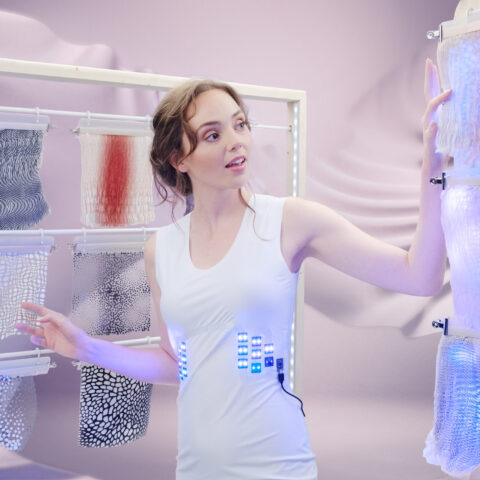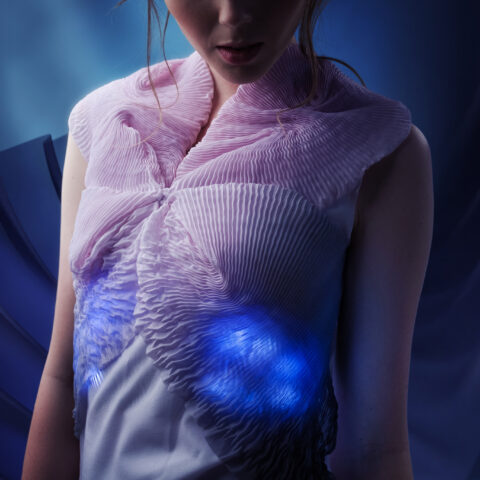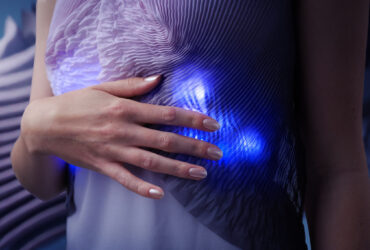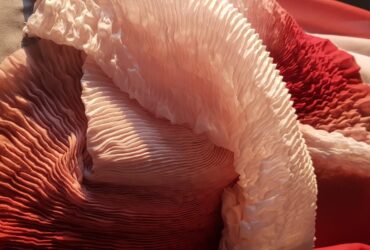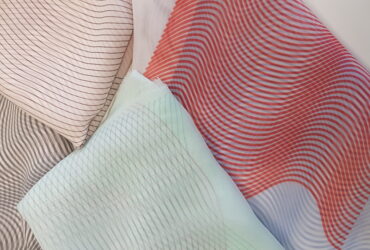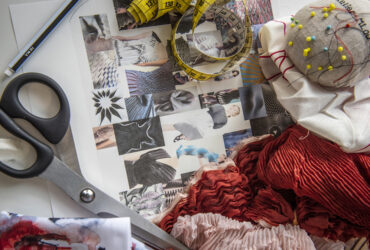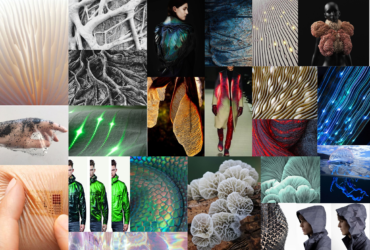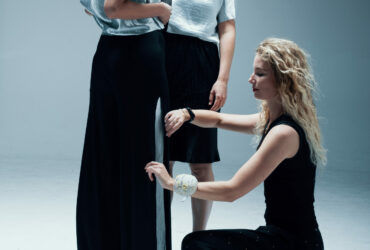The shimmering interplay of layers in Malou Beemer’s Re-FREAM project shine a light on our desire for change in fashion. Beemer approaches garment sustainability though her deep understanding of the social functionality of garments. Her research reflects on how design can change the way we want, wear, and discard fashion. Could smart garments be equipped to improve and maintain their desirability? Her modular Second Skins garment system combines adaptive parts which create a personal light symphony. Its composition responds to the aesthetic need for novelty, for interaction, and for standing out.
Beemer started with deconstructing the idea of the garment itself. First, she explains, “we stepped away from the idea that a garment always has two legs or two sleeves”. Instead, the team decided to visualize it as components. The next step was researching the activation of responsive and reactive textiles elements, which could be modulated to create novelty. With a main focus on evening and party wear, a category showing high single use behavior, the choice fell on color changes based on LED patterns. With her ReFREAM partners, she conceived a garment consisting of a base layer integrating LED lights with IZM Fraunhofer, a diffuse layer which alters the light with Profactor, and a top layer which gives a final shape to the garment as well as allowing for further updates. Wearers can upload LED color patterns, then modulate them with a tap sensor.
Beemer uses the customization of garment colors, patterns, and structures to enhance garment lifespans. She defines sustainability through longevity : the goal is garments that update, perhaps for decades. Her wearable tech designs also aim to enhance social interactions with others. A particularly innovative aspect of her concept is her aim for new levels of garment agency. She envisions clothing which cares for us, according to our social and aesthetic needs. Instead of passive and polluting garments, Beemer envisions fashion as a second skin, with different layers which can shift properties. Allowing for such inbuilt versatility gives garments an active role in their survival, as well as in ours.
Together with the Fraunhofer team, Beemer created two undergarments integrating PCBs (printed circuit boards) and LEDs : one that centered more around the neck, and one more centered around the ribs, below the bust. A DIY prototype of the diffuse layer was created by Beemer, and then perfected by Profactor. The delicate skin-like top layer was hand-pleated by Beemer, who insists that “technical garments don’t need to look super futuristic – they can be soft!”. The garment’s layers physically embody the collaboration between science, industry and artist.
The Seconds Skins garment system reassesses the use of smart textiles, from physical to social and psychological needs. The garment’s modularity also allows for new business models, with multiple transactions. Starting with the purchase of the underdress with integrated LEDs, followed by the rental or purchase of a diffusing mask layer, which creates an interplay of shadows in the garments. The rental or purchase of the top layer completes – or renews – the outfit. The three layers allow wearers to combine and customize novel dress composition every time. Even, as Beemer suggests, by interacting with each other : “what if we would met at a party, and if I think you are wearing an amazing mask layer, and we can just trade it or exchange it?”. The system allows for add-ons such as uploading a new kind of color pattern. A system with which Beemer addresses the question of fashion consumption: “instead of blaming the consumers for a direction that the industry is pushing them into, how can we trigger new, more healthy and sustainable relation towards our garments?”. Due to the construction and modular bonding technique the garment can be repaired when needed or even completely disassembled and the end of life.
The next step for the project will be Dutch Design Week. Beemer aims for the specific prototypes to travel and reach a large audience. As there were two concepts and the partners only got to explore one, she is looking for funds for Second Skins 2.0., in order to explore artificial textile muscles and further develop the idea of adaptive caring garments.
Though working with pandemic restrictions was particularly challenging for lab interactions. Beemer credits conversations with Re-FREAM participants and advisors, such as Isabel Berz , Christiane Luible-Bär and Thomas Gnahm (Wear-It Berlin) for valuable feedback that moved the project forward. Amongst the collaborations she envisions for the future, she would particularly love to work with the Empa facilities for testing for a follow-up project, and with other artists. During a serendipitous conversation with a fellow Re-FREAM grantee Loreto Binvignat Streeter, it became clear that they are working on exactly the same issues, only within different parts of the value chain.
The Project
Malou Beemer reshapes the relation between us and our clothes by integrating body language and non-verbal behaviour into the design process, making fashion design more interactive and responsive.
The Partners
Beemer is based in the Netherlands and worked within the Smart Textile Hub of Re-FREAM. She collaborated with the partners IZM Fraunhofer, Profactor, EMPA and Wear It Berlin.
The Technologies
Together with the Fraunhofer team, Beemer created a pigmented bonding technique which allows PCBs (printed circuit boards) to be bonded on embroidered tracks. They designed a whole track within the undergarments of isolated conductive yarn.
Beemer contributed the jewelry-like design element (“you need to want to wear it!”). The PCBs were bonded with the LED lighting, allowing them to be placed specifically. Usually, LEDs, are linked in a chain: when one of them breaks, the entire chain is damaged.
With the new procedure, the lights are also modular, and can be addressed separately. As a result, the design allows for organic multicolor light patterns.
Robin Hoske, Fraunhofer IZM about the project
“Malou has shown immense adaptability in her project. Outcomes of experimental research are often unpredictable, and sometimes this means shaping your outcome according to your findings.
It was a long journey coming from a wide vision, through researching potential technical solutions, which accomplished a practical working prototype based on the novel modular e-textile hardware kit from Fraunhofer IZM. Upon learning that many of the identified technical solution are not applicable in a real-world application, she transited to lighting as a solution.
The result is a new aesthetic combining LEDs with fashion design. Incorporating customization, technology and modularity into our future clothing is key to new fashion models – a path which Malou’s project envisions exceedingly well. We are sure this is just the beginning.”
The Artist
Malou is a Dutch designer and researcher. She focuses on working with the body and personal space around it. She is fascinated by human behaviour, psychology, movement and the way this translates to nonverbal communication. She graduated (2013) as Master of Arts in Fashion Communication Design.
Follow Malou:
